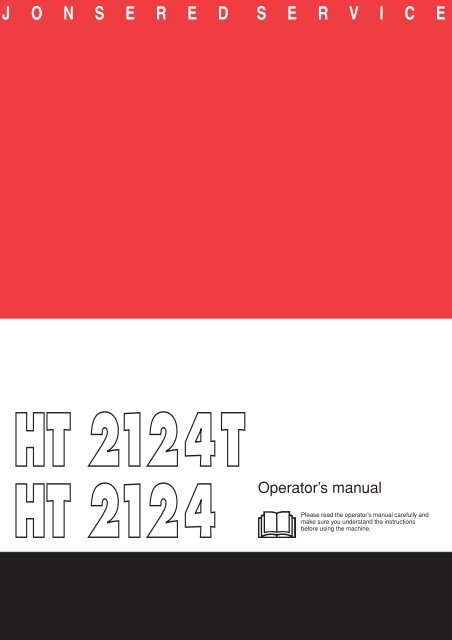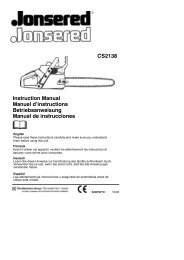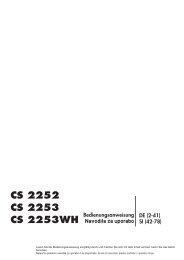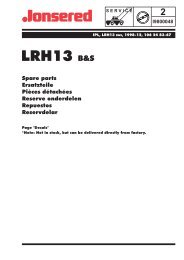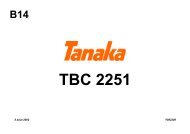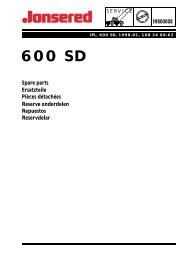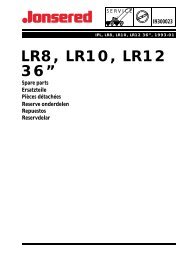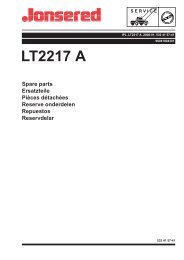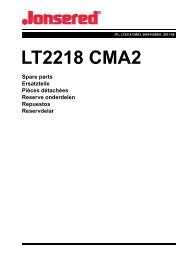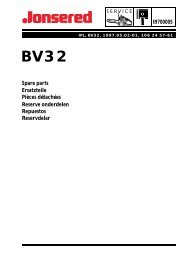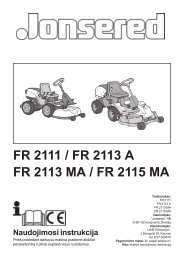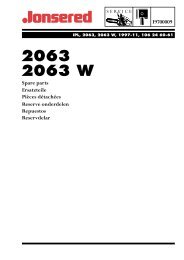Operator's manual - Jonsered
Operator's manual - Jonsered
Operator's manual - Jonsered
- No tags were found...
You also want an ePaper? Increase the reach of your titles
YUMPU automatically turns print PDFs into web optimized ePapers that Google loves.
CONTENTSContentsKEY TO SYMBOLSSymbols ....................................................................... 2CONTENTSContents ...................................................................... 3Note the following before starting: ................................ 3INTRODUCTIONDear customer! ............................................................ 4WHAT IS WHAT?What is what? .............................................................. 5GENERAL SAFETY PRECAUTIONSImportant ...................................................................... 6Personal protective equipment ..................................... 6Machine′s safety equipment ........................................ 6FUEL HANDLINGFuel safety ................................................................... 10Fuel .............................................................................. 10Fueling ......................................................................... 11STARTING AND STOPPINGCheck before starting ................................................... 12Starting and stopping ................................................... 12WORKING TECHNIQUESGeneral working instructions ....................................... 13MAINTENANCECarburetor .................................................................... 15Muffler .......................................................................... 15Cooling system ............................................................ 15Spark plug .................................................................... 15Air filter ......................................................................... 16Gear ............................................................................. 16Cleaning and lubrication .............................................. 16Maintenance schedule ................................................. 17TECHNICAL DATATechnical data .............................................................. 18FEDERAL EMISSION CONTROL WARRANTYSTATEMENTYOUR WARRANTY RIGHTS AND OBLIGATIONS ..... 19Note the following before starting:Please read the operator’s <strong>manual</strong> carefully.Maintenance, replacement, or repair of the emission controldevices and system may be performed by any nonroadengine repair establishment or individual.!!!WARNING! Long-term exposure to noise canresult in permanent hearing impairment. Soalways use approved hearing protection.WARNING! Under no circumstances may thedesign of the machine be modified withoutthe permission of the manufacturer. Alwaysuse genuine accessories. Non-authorizedmodifications and/or accessories can resultin serious personal injury or the death of theoperator or others.Your warranty may not cover damage orliability caused by the use of non-authorizedaccessories or replacement parts.WARNING! Incorrect or careless use of ahedge trimmer can turn it into a dangeroustool that can cause serious or even fatalinjury. It is extremely important that you readand understand the contents of thisoperator’s <strong>manual</strong>.The Emissions Compliance Period referred to on theEmission Compliance label indicates the number of operatinghours for which the engine has been shown to meet Federalemissions requirements.The engine exhaust from this productcontains chemical known to the Stateof California to cause cancer, birthdefects or other reproductive harm.English – 3
INTRODUCTIONDear customer!Congratulations on your choice to buy a <strong>Jonsered</strong> product!Your purchase gives you access to professional help with repairs and service whenever this may be necessary. If the retailer whosells your machine is not one of our authorized dealers, ask for the address of your nearest servicing dealer.It is our wish that you will be satisfied with your product and that it will be your companion for a long time. Think of this operator′s<strong>manual</strong> as a valuable document. By following its′ content (using, service, maintenance etc) the life span and the second-hand valueof the machine can be extended. If you ever lend or sell this machine, make sure that the borrower or buyer gets the operator′s<strong>manual</strong>, so they will also know how to properly maintain and use it.Good luck on using your <strong>Jonsered</strong> machine!<strong>Jonsered</strong> has a policy of continuous product development and therefore reserves the right to modify the design and appearanceof products without prior notice.4 – English
GENERAL SAFETY PRECAUTIONSImportantIMPORTANT!The machine is only designed for cutting branches andtwigs.Never use a machine that has been modified in any wayfrom its original specification.Never use the machine if you are tired, if you have drunkalcohol, or if you are taking medication that could affect yourvision, your judgement or your co-ordination.Wear personal protective equipment. See instructionsunder the heading ”Personal protective equipment”.Never use the machine in extreme weather conditions suchas severe cold, very hot and/or humid climates.Never use a machine that is faulty. Carry out the checks,maintenance and service instructions described in this<strong>manual</strong>. Some maintenance and service measures must becarried out by trained and qualified specialists. Seeinstructions under the heading Maintenance.All covers and guards must be fitted before starting. Ensurethat the spark plug cap and ignition lead are undamaged toavoid the risk of electric shock.!!!WARNING! This machine produces anelectromagnetic field during operation. Thisfield may under some circumstancesinterfere with active or passive medicalimplants. To reduce the risk of serious orfatal injury, we recommend persons withmedical implants to consult their physicianand the medical implant manufacturerbefore operating this machine.WARNING! Running an engine in a confinedor badly ventilated area can result in deathdue to asphyxiation or carbon monoxidepoisoning.WARNING! Faulty blades can increase therisk of accidents.Personal protective equipment!HEARING PROTECTIONWear hearing protection that provides adequate noisereduction.EYE PROTECTIONAlways wear approved eye protection. If you use a visor thenyou must also wear approved protective goggles. Approvedprotective goggles must comply with standard ANSI Z87.1 inthe USA or EN 166 in EU countries.GLOVESGloves should be worn when necessary, e.g., when fittingcutting attachments.BOOTSWear sturdy, non-slip boots or shoes.CLOTHINGWear clothes made of a strong fabric and avoid loose clothingthat can catch on twigs and branches. Always wear heavy,long pants. Do not wear jewellery, shorts sandals or gobarefoot. Secure hair so it is above shoulder level.FIRST AID KITWARNING! Listen out for warning signals orshouts when you are wearing hearingprotection. Always remove your hearingprotection as soon as the engine stops.Always have a first aid kit nearby.IMPORTANT!Incorrect or careless use of a hedge trimmer can turn it intoa dangerous tool that can cause serious or even fatal injury.It is extremely important that you read and understand thecontents of this operator’s <strong>manual</strong>.You must use approved personal protective equipmentwhenever you use the machine. Personal protectiveequipment cannot eliminate the risk of injury but it willreduce the degree of injury if an accident does happen. Askyour dealer for help in choosing the right equipment.Machine′s safety equipmentThis section describes the machine′s safety equipment, itspurpose, and how checks and maintenance should be carriedout to ensure that it operates correctly. See the ”What iswhat?” section to locate where this equipment is positionedon your machine.6 – English
GENERAL SAFETY PRECAUTIONSThe life span of the machine can be reduced and the risk ofaccidents can increase if machine maintenance is not carriedout correctly and if service and/or repairs are not carried outprofessionally. If you need further information please contactyour nearest servicing dealer.Press the throttle lockout and make sure it returns to itsoriginal position when you release it.IMPORTANT!All servicing and repair work on the machine requiresspecial training. This is especially true of the machine′ssafety equipment. If your machine fails any of the checksdescribed below you must contact your service agent.When you buy any of our products we guarantee theavailability of professional repairs and service. If the retailerwho sells your machine is not a servicing dealer, ask him forthe address of your nearest service agent.!WARNING! Never use a machine with faultysafety equipment. The machine’s safetyequipment must be checked and maintainedas described in this section. If your machinefails any of these checks contact yourservice agent to get it repaired.Throttle lockoutThe throttle lockout is designed to prevent accidentaloperation of the throttle control. When you press the lock (A)(i.e. when you grasp the handle) it releases the throttle control(B). When you release the handle the throttle control and thethrottle lockout both move back to their original positions. Thismovement is controlled by two independent return springs.This arrangement means that the throttle control isautomatically locked at the idle setting.Check that the throttle control and throttle lockout move freelyand that the return springs work properly.See instructions under the heading Start. Start the hedgetrimmer and apply full throttle. Release the throttle trigger andcheck that the blades stop and remain stationary. If the bladesmove when the throttle trigger is in the idle position then thecarburettor idle setting must be adjusted. See instructionsunder the heading Maintenance.Stop switchUse the stop switch to switch off the engine.Make sure the throttle control is locked at the idle settingwhen the throttle lockout is released.Start the engine and make sure the engine stops when youmove the stop switch to the stop setting.Hand guardThe hand guard prevents hands from coming into contact withthe moving blades, for example, if the operator loses grip onthe front handle.Check that the hand guard is fitted correctly.Check that the hand guard is undamaged.English – 7
GENERAL SAFETY PRECAUTIONSVibration damping systemNever use a machine that has a faulty muffler.Your machine is equipped with a vibration damping systemthat is designed to reduce vibration and make operationeasier.The machine′s vibration damping system reduces the transferof vibration between the engine unit/cutting equipment andthe machine′s handle unit. The engine body including theblades is suspended on the handlebar system via a foursprings.Regularly check that the muffler is securely attached to themachine.Regularly check the vibration damping units for cracks ordeformation. Check that the vibration damping element isundamaged and securely attached.If the muffler on your machine is fitted with a spark arrestorscreen this must be cleaned regularly. A blocked screen willcause the engine to overheat and may lead to seriousdamage.!MufflerWARNING! Overexposure to vibration canlead to circulatory damage or nerve damagein people who have impaired circulation.Contact your doctor if you experiencesymptoms of overexposure to vibration.Such symptoms include numbness, loss offeeling, tingling, pricking, pain, loss ofstrength, changes in skin colour orcondition. These symptoms normally appearin the fingers, hands or wrists. The riskincreases at low temperatures.The muffler is designed to keep noise levels to a minimumand to direct exhaust fumes away from the user. A mufflerfitted with a catalytic converter is also designed to reduceharmful exhaust gases.In countries that have a warm and dry climate there is asignificant risk of fire. We therefore fit certain mufflers with aspark arrestor screen. Check whether the muffler on yourmachine is fitted with this kind of screen.!!!WARNING! Mufflers fitted with catalyticconverters get very hot during use andremain so for some time after stopping. Thisalso applies at idle speed. Contact can resultin burns to the skin. Remember the risk offire!WARNING! The inside of the muffler containchemicals that may be carcinogenic. Avoidcontact with these elements in the event of adamaged muffler.WARNING! Bear in mind that:The exhaust fumes from the engine are hotand may contain sparks which can start afire. Never start the machine indoors or nearcombustible material!For mufflers it is very important that you follow the instructionson checking, maintaining and servicing your machine.8 – English
GENERAL SAFETY PRECAUTIONSBladesTo ensure good cutting results it is important that the contactpressure between the blades is correct. The contact pressureis adjusted by turning the screws on the underside of the barclockwise as far as they will go. Then turn the screwsanticlockwise a 1/4 turn. Lock the screws using the locking nuton the top of the bar. Check that the screws are loose enoughto allow the washers under the screw heads to slide sideways.When the blades are correctly adjusted the play between theblades should be 0,2–0,4 mm, measured at the screws.The edges of the blades are too hard to be filed. Dull bladesshould be sharpened using a grinder.Replace the blades if they are bent or damaged.Blade guardThe blade guard (A) is intended to protect against any part ofthe body coming into contact with the blades (B).ABCheck that the blade guard is not damaged or distorted.Replace the blade guard if it is bent or damaged.GearThe gear housing gets hot when the machine has been inuse. To avoid burning yourself do not touch the gear housing.English – 9
FUEL HANDLINGFuel safetyGasolineNever start the machine:1 If you have spilled fuel on it. Wipe off the spillage and allowremaining fuel to evaporate.2 If you have spilled fuel on yourself or your clothes, changeyour clothes. Wash any part of your body that has come incontact with fuel. Use soap and water.3 If the machine is leaking fuel. Check regularly for leaksfrom the fuel cap and fuel lines.Transport and storage• Store and transport the machine and fuel so that there isno risk of any leakage or fumes coming into contact withsparks or naked flames, for example, from electricalmachinery, electric motors, electrical relays/switches orboilers.• When storing and transporting fuel always use approvedcontainers intended for this purpose.• When storing the machine for long periods the fuel tankmust be emptied. Contact your local gas station to find outwhere to dispose of excess fuel.• Ensure the machine is cleaned and that a completeservice is carried out before long-term storage.• The transport guard must always be fitted to the cuttingattachment when the machine is being transported or instorage.• Secure the machine during transport.!FuelCAUTION! The machine is equipped with a two-strokeengine and must always been run using a mixture of gasolineand two-stroke engine oil. It is important to accuratelymeasure the amount of oil to be mixed to ensure that thecorrect mixture is obtained. When mixing small amounts offuel, even small inaccuracies can drastically affect the ratio ofthe mixture.!WARNING! Take care when handling fuel.Bear in mind the risk of fire, explosion andinhaling fumes.WARNING! Fuel and fuel fumes are highlyinflammable and can cause serious injurywhen inhaled or allowed to come in contactwith the skin. For this reason observecaution when handling fuel and make surethere is adequate ventilation.CAUTION! Always use a quality gasoline/oil mixture with anoctane rating of at least 87 octane ((RON+MON)/2). If yourmachine is equipped with a catalytic converter (see chapteron Technical data) always use a good quality unleadedgasoline/oil mixture. Leaded gasoline will destroy the catalyticconverter.Use low-emission gasoline, also known as alkylate gasoline,if it is available.This engine is certified to operate on unleaded gasoline.• The lowest recommended octane grade is 87((RON+MON)/2). If you run the engine on a lower octanegrade than 87 so-called knocking can occur. This givesrise to a high engine temperature and increased bearingload, which can result in serious engine damage.• When working at continuous high revs a higher octanerating is recommended.Two-stroke oil• For best results and performance use JONSERED twostrokeengine oil, which is specially formulated for our aircooledtwo stroke-engines.• Never use two-stroke oil intended for water-cooledengines, sometimes referred to as outboard oil (ratedTCW).• Never use oil intended for four-stroke engines.• Mixing ratio1:50 (2%) with JONSERED two-stroke oil.Gasoline, litreTwo-stroke oil, litre2% (1:50)5 0,1010 0,2015 0,3020 0,40US gallon US fl. oz.1 2 1/22 1/2 6 1/25 12 7/810 – English
FUEL HANDLINGMixing• Always mix the gasoline and oil in a clean containerintended for fuel.• Always start by filling half the amount of the gasoline to beused. Then add the entire amount of oil. Mix (shake) thefuel mixture. Add the remaining amount of gasoline.• Mix (shake) the fuel mixture thoroughly before filling themachine’s fuel tank.• Do not mix more than one month’s supply of fuel at a time.• If the machine is not used for some time the fuel tankshould be emptied and cleaned.!WARNING! The catalytic converter mufflergets very hot during and after use. This alsoapplies during idling. Be aware of the firehazard, especially when working nearflammable substances and/or vapours.Fueling!WARNING! Taking the following precautions,will lessen the risk of fire:Do not smoke or place hot objects near fuel.Always shut off the engine before refuelling.Always stop the engine and let it cool for afew minutes before refuelling.When refuelling, open the fuel cap slowly sothat any excess pressure is released gently.Tighten the fuel cap carefully after refuelling.Always move the machine away from therefuelling area before starting.• Clean the area around the fuel cap. Contamination in thetank can cause operating problems.• Ensure that the fuel is well mixed by shaking the containerbefore filling the tank.English – 11
STARTING AND STOPPINGCheck before startingChoke: Set the choke control in the choke position.• Inspect the working area. Remove any objects that couldbe thrown out.• Check the cutting attachment. Never use blades that aredull, cracked or damaged.• Check that the machine is in perfect working order. Checkthat all nuts and screws are tight.• Make sure the gear housing is lubricated correctly. Seeinstructions under the heading Gear housing.• Check that the cutting attachment always stops when theengine is idling.• Only use the machine for the purpose it was intended for.• Make sure that the handle and safety features are in goodworking order. Never use a machine that lacks a part orhas been modified outside its specifications.• All covers must be correctly fitted and undamaged beforeyou start the machine.Starting and stopping!WARNING! The complete clutch cover andgear housing must be fitted before themachine is started, otherwise the clutch maycome loose and cause personal injury.Always move the machine about 3 metresfrom the refuelling position before starting.Place the machine on a firm surface.Remember that the blades may start to movewhen the engine is started. Make sure theblades cannot come into contact with anyobject. Make sure that no unauthorisedpersons are in the working area, otherwisethere is a risk of serious personal injury. Thesafety distance is 15 metres.Warm enginePrimer bulb: Press the air purge repeatedly until fuel beginsto fill the bulb. The bulb need not be completely filled.StartingHold the body of the machine on the ground using your lefthand (CAUTION! Not with your foot!). Grip the starter handle,slowly pull out the cord with your right hand until you feelsome resistance (the starter pawls grip), now quickly andpowerfully pull the cord. Never wrap the starter cord aroundyour handPush the choke control back to its original position as soon asthe engine fires, and continue trying to start until the enginestarts.CAUTION! Do not pull the starter cord all the way out and donot let go of the starter handle when the cord is fully extended.This can damage the machine.Cold engineIgnition: Set the stop switch to the start position.Primer bulb: Press the air purge repeatedly until fuel beginsto fill the bulb. The bulb need not be completely filled.StoppingThe engine is switched off by moving the stop switch to thestop position.12 – English
WORKING TECHNIQUESGeneral working instructions• Always use both hands to hold the machine. Hold themachine in front of your body.IMPORTANT!This section takes up the basic safety precautions forworking with a hedge trimmer.If you encounter a situation where you are uncertain how toproceed you should ask an expert. Contact your dealer oryour service workshop.Avoid all usage which you consider to be beyond yourcapability.!WARNING! The machine can cause seriouspersonal injury. Read the safety instructionscarefully. Learn how to use the machine.• Make sure that your hands and feet do not come near thecutting attachment when the engine is running.!WARNING! Cutting tool. Do not touch thetool without first switching off the engine.Safety instructions regarding thesurroundings• Never allow children to use the machine.• Ensure that no-one comes closer than 15 m while you areworking.• Never allow anyone else to use the machine without firstensuring that they have understood the contents of theoperator’s <strong>manual</strong>.• Never work from a ladder, stool or any other raisedposition that is not fully secured.• Keep in mind that the operator is responsible for accidentsor hazards occuring to other people or their property.Safety instructions while working• When the engine is switched off, keep your hands and feetaway from the cutting attachment until it has stoppedcompletely.• Watch out for stumps of branches that can be thrown outduring cutting.• Do not cut too close to the ground. Stones and otherobjects can be thrown out.• Check the working area for foreign objects such aselectricity cables, insects and animals, etc, or otherobjects that could damage the cutting attachment, suchas metal items.• If any foreign object is hit or if vibrations occur stop themachine immediately. Disconnect the HT lead from thespark plug. Check that the machine is not damaged.Repair any damage.• If anything jams in the blades while you are working,switch off the engine and wait until it has stoppedcompletely before cleaning the blades. Disconnect the HTlead from the spark plug.• Never put the machine down with the engine runningunless you have it in clear sight.Safety instructions after completing work• Always ensure you have a safe and stable workingposition.• The transport guard should always be fitted to the cuttingattachment when the machine is not in use.• Make sure the cutting attachment has stopped beforecleaning, carrying out repairs or an inspection.Disconnect the HT lead from the spark plug.English – 13
WORKING TECHNIQUES• Always wear heavy-duty gloves when repairing the cuttingattachment. This is extremely sharp and can easily causecuts.• Store the machine out of reach of children.• Use only original spare parts for repairs.Basic working techniques• Work with a swinging action from the bottom upwardswhen trimming sides.• Adjust the throttle setting to suit the load.• When trimming a hedge the engine should always faceaway from the hedge.• Hold the machine as close to your body as possible to getthe best balance.• Make sure that the tip does not touch the ground.• Do not rush the work, but work steadily until all thebranches have been cut back cleanly.HT2124T• The hedge trimmer’s rear handle can be set in threepositions by pulling out the catch. See figure. When thehandle is adjusted the hedge trimmer should be idling ornot running.• While working the handle should always be facingupwards irrespective of how the hedge trimmer isdirected.14 – English
MAINTENANCECarburetorAdjusting the idle speedThe T-screw regulates the throttle setting at idle speed. If theT-screw is turned clockwise this gives a higher idle speed;turning it anti-clockwise gives a lower idle speed.Before any adjustments are made, make sure that the air filteris clean and the air filter cover is fitted.Adjust the idle speed with the idle adjustment screw T, ifadjustment is necessary. First turn the idle adjustment screwT clockwise until the blades start to move. Then turn the idleadjustment screw T anticlockwise until the blades stop. Theidle speed is correctly adjusted when the engine runssmoothly in every position. There should also be a clearmargin to the speed at which the blades start to move. Theblades must also remain stationary when the choke control isin the start throttle position.On mufflers without a catalytic converter the screen should becleaned weekly, or replaced if necessary. On mufflers fittedwith a catalytic converter the screen should be checked, andif necessary cleaned, monthly. If the screen is damaged itshould be replaced. If the screen is frequently blocked, thiscan be a sign that the performance of the catalytic converteris impaired. Contact your dealer to inspect the muffler. Ablocked screen will cause the machine to overheat and resultin damage to the cylinder and piston. See also instructionsunder the heading Maintenance.CAUTION! Never use a machine with a defective muffler.!WARNING! Mufflers fitted with catalyticconverters get very hot during use andremain so for some time after stopping. Thisalso applies at idle speed. Contact can resultin burns to the skin. Remember the risk offire!Cooling systemTo keep the working temperature as low as possible themachine is equipped with a cooling system.!WARNING! If the idle speed cannot beadjusted so that the cutting attachmentstops, contact your dealer/serviceworkshop. Do not use the machine until ithas been correctly adjusted or repaired.21MufflerThe cooling system consists of:CAUTION! Some mufflers are fitted with a catalyticconverter. See chapter on Technical data to see whether yourmachine is fitted with a catalytic converter.The muffler is designed to reduce the noise level and to directthe exhaust gases away from the operator. The exhaustgases are hot and can contain sparks, which may cause fireif directed against dry and combustible material.1 Cooling fins on the cylinder.2 Cylinder cover (directs cold air over the cylinder).Clean the cooling system with a brush once a week, moreoften in demanding conditions. A dirty or blocked coolingsystem results in the machine overheating which causesdamage to the piston and cylinder.Spark plugThe spark plug condition is influenced by:• Incorrect carburetor adjustment.Some mufflers are equipped with a special spark arrestorscreen. If your machine has this type of muffler, you shouldclean the screen at least once a week. This is best done witha wire brush.• An incorrect fuel mixture (too much or incorrect type ofoil).• A dirty air filter.These factors cause deposits on the spark plug electrodes,which may result in operating problems and startingdifficulties.English – 15
MAINTENANCEIf the machine is low on power, difficult to start or runs poorlyat idle speed: always check the spark plug first before takingany further action. If the spark plug is dirty, clean it and checkthat the electrode gap is 0.7 mm (0,028"). The spark plugshould be replaced after about a month in operation or earlierif necessary.Put the filter in a plastic bag and pour the filter oil over it.Knead the plastic bag to distribute the oil. Squeeze theexcess oil out of the filter inside the plastic bag and pour offthe excess before fitting the filter to the machine. Never usecommon engine oil. This would drain through the filter quitequickly and collect in the bottom.GearCAUTION! Always use the recommended spark plug type!Use of the wrong spark plug can damage the piston/cylinder.Check that the spark plug is fitted with a suppressor.Air filterThere is a grease nipple and a plug for filling lubricant on thegear housing. Use a grease gun to fill with grease. This shouldbe done after every 60 working hours. Use <strong>Jonsered</strong> specialgrease.The air filter must be regularly cleaned to remove dust and dirtin order to avoid:• Carburettor malfunctions• Starting problems• Loss of engine power• Unnecessary wear to engine parts• Excessive fuel consumption.Clean the filter every 25 hours, or more regularly if conditionsare exceptionally dusty.CAUTION! The gear housing must not be filled completelywith grease. The grease expands as the machine heats upduring operation. If the gear housing was completely filledwith grease it could damage the seals and lead to leakage ofgrease.The grease in the bevel gear does not normally need to bechanged except if repairs are carried out.Cleaning and lubricationCleaning the air filterRemove the air filter cover and take out the filter. Wash itclean in warm, soapy water. Ensure that the filter is dry beforerefitting it.An air filter that has been in use for a long time cannot becleaned completely. The filter must therefore be replaced witha new one at regular intervals. A damaged air filter mustalways be replaced.If the machine is used in dusty conditions the air filter shouldbe soaked in oil. See instructions under the heading Oiling theair filter.Oiling the air filterAlways use special filter oil. Filter oil contains a solvent tomake it spread evenly through the filter. You should thereforeavoid skin contact.Clean any resin and plant residue from the blades usingcleaning agent before and after using the machine.Lubricate the blade bars with special grease before longperiods of storage.IMPORTANT! Use only JONSERED replacement parts.Use of other brands of replacement parts can causedamage to your unit or injury to the operator or others. Yourwarranty does not cover damage or liability caused by theuse of accessories and/or attachments not specificallyrecommended by JONSERED.16 – English
MAINTENANCEMaintenance scheduleThe following is a list of the maintenance that must be performed on the machine. Most of the items are described in theMaintenance section. The user must only carry out the maintenance and service work described in this <strong>manual</strong>. More extensivework must be carried out by an authorized service workshop.MaintenanceClean the outside of the machine.Make sure the throttle trigger lock and the throttle function correctly from asafety point of view.Check that the stop switch works correctly.Check that the blades do not move when the engine is idling or when thechoke is in the start throttle position.Check that the blades are undamaged and show no signs of cracking orother damage. Replace the blades if necessary.Check that the blade guard is not damaged or distorted. Replace the bladeguard if it is bent or damaged.Clean the air filter. Replace if necessary.Check that the hand guard is not damaged. Replace the guard if damaged.Check that nuts and screws are tight.Check that there are no fuel leaks from the engine, tank or fuel lines.Check the starter and starter cord.Check that the vibration damping elements are not damaged.Clean the outside of the spark plug. Remove it and check the electrodegap. Adjust the gap to 0.5 mm (.20”), or replace the spark plug. Check thatthe spark plug is fitted with a suppressor.Clean the machine’s cooling system.Clean or replace the spark arrestor screen on the muffler (only applies tomufflers without a catalytic converter).Clean the outside of the carburettor and the space around it.Fill the gear housing with grease. This should be carried out approximatelyevery 60 working hours.Check that the screws that hold the blades together are correctlytightened.Clean the fuel tank.Check the fuel filter from contamination and the fuel hose from cracks orother defects. Replace if necessary.Check all cables and connections.Check the clutch, clutch springs and the clutch drum for wear. Replace ifnecessary by an autorized service workshop.Replace the spark plug. Check that the spark plug is fitted with asuppressor.Check and clean the spark arrestor screen on the muffler (only applies tomufflers fitted with a catalytic converter).To reduce the fire hazard, clean dirt, leaves and surplus lubricant, etc fromthe muffler and engine.DailymaintenanceXXXXXXXXXXWeeklymaintenanceXXXXXXXXMonthlymaintenanceXXXXXXXEnglish – 17
TECHNICAL DATATechnical dataTechnical data HT2124 HT2124TMotorCylinder displacement, cu.in/cm 3 1.37/22.5 1.37/22.5Cylinder bore, inch/mm 1.26/32.0 1.26/32.0Stroke, inch/mm 1.10/28 1.10/28Idle speed, rpm 3000 3000Recommended max. speed, rpm 12000 12000Max. engine output, acc. to ISO 8893, kW/ rpm 0.6/7000 0.6/7000Catalytic converter muffler No NoSpeed-regulated ignition system No NoIgnition systemSpark plug NGK BPMR 6Y NGK BPMR 6YElectrode gap, inch/mm 0.03/0.7 0.03/0.7Fuel and lubrication systemFuel tank capacity, US pint/litre 1.06/0.5 1.06/0.5WeightWeight without fuel, Lbs/kg 11.2/5.1 11.4/5.2Sound levels(see note 1)Equivalent sound pressure level at the operator’s ear,measured according to ISO 22868, dB(A):97 95Vibration levels(see note 2)Equivalent vibration levels (a hv,eq ) at handles, measuredaccording to ISO 22867, m/s 2Front/rear handles: 4.1/3.5 4.1/3.0BladesType Double sided Double sidedLength, mm 550 600Blade speed, cuts/min 3765 3765Note 1: Reported data for equivalent sound pressure level for the machine has a typical statistical dispersion (standard deviation)of 1 dB (A).Note 2: Reported data for equivalent vibration level has a typical statistical dispersion (standard deviation) of 1 m/s 2 .18 – English
FEDERAL EMISSION CONTROL WARRANTY STATEMENTYOUR WARRANTY RIGHTS ANDOBLIGATIONSThe EPA (U.S. Environmental Protection Agency),Environment Canada and <strong>Jonsered</strong> are pleased to explainthe emissions control system’s warranty on your 2010 andlater small off-road engine. In U.S. and Canada, newequipment that use small off-road engines must be designed,built, and equipped to meet the applicable Federal stringentanti-smog standards. <strong>Jonsered</strong> must warrant the emissionscontrol system on your small off-road engine for the periodlisted below provided there has been no abuse, neglect orimproper maintenance of your equipment. Your emissionscontrol system may include parts such as the carburetor,ignition system, catalytic converter, fuel tank, filters and otherassociated components. Also, included may be hoses, belts,connectors, sensors, and other emission-related assemblies.Where a warrantable condition exists, <strong>Jonsered</strong> will repairyour small off-road engine at no cost to you includingdiagnosis, parts and labor.MANUFACTURER′S WARRANTYCOVERAGEThe emissions control system is warranted for two years. Ifany emissions-related part on your equipment is defective,the part will be repaired or replaced by <strong>Jonsered</strong>.OWNER′S WARRANTY RESPONSIBILITIES• As the small off-road engine owner, you are responsiblefor performance of the required maintenance listed in youroperator’s <strong>manual</strong>. <strong>Jonsered</strong> recommends that you retainall receipts covering maintenance on your small off-roadengine, but <strong>Jonsered</strong> cannot deny warranty solely for thelack of receipts or your failure to ensure the performanceof all scheduled maintenance.• As the small off-road engine owner, you should howeverbe aware that <strong>Jonsered</strong> may deny you warranty coverageif your small off-road engine or a part has failed due toabuse, neglect, or improper maintenance or unapprovedmodifications.• You are responsible for presenting your small off-roadengine to a <strong>Jonsered</strong> distribution center or service centeras soon as the problem exists. The warranty repairsshould be completed in a reasonable amount of time, notto exceed 30 days. If you have any questions regardingyour warranty coverage, you should contact HusqvarnaForest & Garden, at 1-800-487-5951 or visitwww.charlotte.usa.jonsered.com.WARRANTY COMMENCEMENT DATEThe warranty period begins on the date the engine orequipment is delivered to an ultimate purchaser.LENGTH OF COVERAGE<strong>Jonsered</strong> warrants to the ultimate purchaser and eachsubsequent owner that the engine or equipment is designed,built, and equipped so as to conform with all applicableregulations adopted by EPA, and is free from defects inmaterials and workmanship that causes the failure of awarranted part for a period of two years.WHAT IS COVEREDREPAIR OR REPLACEMENT OF PARTS Repair orreplacement of any warranted part under the warranty mustbe performed at no charge to the owner at a warranty station.Warranty services or repairs will be provided at all <strong>Jonsered</strong>distribution centers that are franchised to service the subjectengines. Throughout the emissions warranty period of twoyears, <strong>Jonsered</strong> must maintain a supply of warranted partssufficient to meet the expected demand for such parts.WARRANTY PERIOD Any warranted part that is scheduledfor replacement as required in the maintenance schedule, iswarranted for the period of time prior to the first scheduledreplacement point for that part. If the part fails prior to the firstscheduled replacement, the part will be repaired or replacedby Husqvarna Forest & Garden at no cost. Any such partrepaired or replaced under warranty is warranted for theremainder of the period prior to the first scheduledreplacement point for the part. Any warranted part that is notscheduled for replacement as required in the maintenanceschedule, is warranted for two years. If any such part failsduring the period of warranty coverage, it will be repaired andreplaced by Husqvarna Forest & Garden at no cost. Any suchpart repaired or replaced under the warranty is warranted forthe remaining warranty period. Any warranted part that isscheduled only for regular inspection in the maintenanceschedule will be warranted for a period of two years. Astatement in such written instructions to the effect of ”repair orreplace as necessary” will not reduce the period of warrantycoverage. Any such part repaired or replaced under warrantywill be warranted for the remaining warranty period.DIAGNOSIS The owner must not be charged for diagnosticlabor that leads to the determination that a warranted part isin fact defective, provided that such diagnostic work isperformed at a warranty station.CONSEQUENTIAL DAMAGES <strong>Jonsered</strong> is liable fordamages to other engine components proximately caused bya failure under warranty of any warranted part.EMISSION WARRANTY PARTS LIST1 Carburetor and internal parts2 Intake pipe, airfilter holder and carburetor bolts.3 Airfilter and fuelfilter covered up to maintenance schedule.4 Spark Plug, covered up to maintenance schedule5 Ignition Module6 Muffler with catalytic converter7 Fuel tankWHAT IS NOT COVEREDAll failures caused by abuse, neglect or impropermaintenance are not covered.ADD -ON OR MODIFIED PARTSAdd-on or modified parts that are not exempted by EPA maynot be used. The use of any non-exempted add-on ormodified parts will be grounds for disallowing a warrantyclaim. <strong>Jonsered</strong> will not be liable to warrant failures ofwarranted parts caused by the use of a non-exempted add-onor modified part.HOW TO FILE A CLAIMIf you have any questions regarding your warranty rights andresponsibilities, you should contact your nearest authorizedservicing dealer or call Husqvarna Forest & Garden, at 1-800-487-5951 or visit www.charlotte.usa.jonsered.com.WHERE TO GET WARRANTY SERVICEWarranty services or repairs are provided through all<strong>Jonsered</strong> authorized servicing dealers.MAINTENANCE, REPLACEMENT ANDREPAIR OF EMISSION-RELATED PARTSAny replacement part may be used in the performance of anywarranty maintenance or repairs and must be providedwithout charge to the owner. Such use will not reduce thewarranty obligations of the manufacturer.MAINTENANCE STATEMENTThe owner is responsible for the performance of all requiredmaintenance, as defined in the operator’s <strong>manual</strong>.English – 19
Original instructions1153206-95´®z+U4e5Y¨´®z+U4e5Y¨ 2010-04-28


